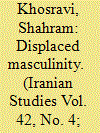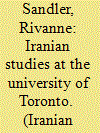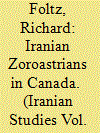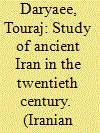| Srl | Item |
| 1 |
ID:
091289


|
|
|
|
|
| Publication |
2009.
|
| Summary/Abstract |
Masculinity, like other kinds of social identity, is an ongoing construction in a dialogue between one's self-image and others' perceptions of one. The interplay between ethnicity and masculinity is a main theme in this article. Due to geographical displacement, the Iranian man's masculine identity has been challenged and renegotiated on the one hand by Iranian women's struggle for emancipation and on the other hand by the Swedish mediawork. Iranian men are displaced from the position of having a powerful gaze, which fixed and controlled women into a position of being an object of the gaze of others. The dominant gaze in Sweden makes them (in)visible in the same way their gaze makes women (in)visible in Iran.
|
|
|
|
|
|
|
|
|
|
|
|
|
|
|
|
| 2 |
ID:
091291


|
|
|
|
|
| Publication |
2009.
|
| Summary/Abstract |
The electoral process is one of the many features of modern Iran, including the administrative structure, that were introduced in the early twentieth century and have survived both Pahlavi rule and the 1979 revolution. Despite regular parliamentary elections being held during Pahlavi rule, these were primarily symbolic exercises with limited political consequence and societal involvement.
|
|
|
|
|
|
|
|
|
|
|
|
|
|
|
|
| 3 |
ID:
091283


|
|
|
|
|
| Publication |
2009.
|
| Summary/Abstract |
This essay addresses itself to the century long history of cinema in Iran, focusing on the history of the senses as they combine with and are extended by film technologies. It argues that Khomeini's aim was to produce a transformed and Shiite Iran by purifying the sensorial national body by means of film technologies.
|
|
|
|
|
|
|
|
|
|
|
|
|
|
|
|
| 4 |
ID:
091290


|
|
|
|
|
| Publication |
2009.
|
| Summary/Abstract |
The International Society for Iranian Studies (ISIS) fortieth anniversary celebration at the University of Toronto provided an opportunity to research and record the development of Iranian studies at the university. Iranian studies emerged in 1961 as a major sub-field of the newly established Department of Islamic Studies (now the Department of Near and Middle Eastern Civilizations (NMC)). Presently, the university has a diverse and yet cohesive cadre of academic talent and offers a breadth of courses, which makes it unique in Canada. The language-based discipline of an earlier generation of scholars has become the present multi-faceted program of today, addressing a wide variety of academic and community interests. The University of Toronto academic tradition, the scholarship of early faculty, and the immigration of Iranians have contributed to shaping Iranian studies in Toronto.
|
|
|
|
|
|
|
|
|
|
|
|
|
|
|
|
| 5 |
ID:
091287


|
|
|
|
|
| Publication |
2009.
|
| Summary/Abstract |
Canada, now the number-one destination for Iranian migrants, is home to one of the world's most dynamic Zoroastrian communities, in which Iranians are increasingly represented and are playing ever more visible roles in maintaining and transforming the tradition. While exile has in some ways reunited Iranian and Parsi (South Asian) Zoroastrians after more than 1,000 years of separation, cultural and in some cases religious differences mean that they continue largely to live in separate spheres even while sharing their places of worship. Iranian Zoroastrians in Canada participate in some social settings as Iranians, in others as Zoroastrians, and in still others as Canadians, but to a large extent they remain a community unto themselves separate from these other three. Even so, their generally progressive interpretations of Zoroastrianism are having an influence on Parsi communities worldwide as well as on Zoroastrians in Iran, and being often recognized as "original Iranians" they are playing important roles in promoting awareness of Iranian culture within the broader community.
|
|
|
|
|
|
|
|
|
|
|
|
|
|
|
|
| 6 |
ID:
091285


|
|
|
|
|
| Publication |
2009.
|
| Summary/Abstract |
In the mid-nineteenth century, Parsis reestablished ties with Zoroastrians in Iran that had languished due to decades-long internal unrest in Iran. In 1854 reformists in India established the Society for the Amelioration of Conditions in Iran and sent a representative to Iran-Maneckji Hataria. Hataria was charged with eliminating the onerous non-Muslim tax owed by the Zoroastrians (the jaziyeh). Hataria also organized the Iranian Zoroastrian community, and funded a variety of community projects. He also brought Parsi reformist ideas to Iran, and attempted to reshape Iranian religious practice and belief along Parsi lines. This article explores the effects of Parsi reformist ideas on Iran, and Hataria's own writings concerning Zoroastrianism and its relationship to Iranian national identity.
|
|
|
|
|
|
|
|
|
|
|
|
|
|
|
|
| 7 |
ID:
091288


|
|
|
|
|
| Publication |
2009.
|
| Summary/Abstract |
The following article discusses the development of ancient Iranian studies, namely the important philological, archaeological, religious, and historical discoveries in the twentieth century and how they have changed our views of ancient Iran and its impact on modern Iranian identity. The essay also previews the use and abuse of ancient Iranian studies by the state and their focus on the newly discovered Achaemenid Empire at the cost of Arsacid and Sasanian dynasties.
|
|
|
|
|
|
|
|
|
|
|
|
|
|
|
|